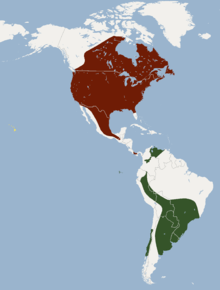Hoary bat
| Hoary bat | |
|---|---|
.jpg) | |
| Scientific classification | |
| Kingdom: | Animalia |
| Phylum: | Chordata |
| Class: | Mammalia |
| Order: | Chiroptera |
| Family: | Vespertilionidae |
| Genus: | Lasiurus |
| Species: | L. cinereus |
| Binomial name | |
| Lasiurus cinereus (Beauvois, 1796) | |
 | |
| Distribution of the hoary bat (2008) | |
The hoary bat (Lasiurus cinereus) is a species of bat in the vesper bat family, Vespertilionidae. It occurs throughout most of North America and much of South America, with disjunct populations in the Galápagos Islands and Hawaii.
Description
The hoary bat averages 13 to 14.5 cm (5.1 to 5.7 in) long with a 40 cm (15.5 in) wingspan and a weight of 26 g (0.92 oz). It is the largest bat normally found in Canada. Its coat is dense and dark brown, with white tips to the hairs that give the species its 'hoary' appearance for which it is named.[2] The body is covered in fur except for the undersides of the wings. Males and females are dimorphic in body mass, with females 40% heavier than males.[3]
Behavior
The bat normally roosts alone on trees, hidden in the foliage, but on occasion has been seen in caves with other bats. It prefers woodland, mainly coniferous forests, but hunts over open areas or lakes. It hunts alone and its main food source is moths. The bats can cover an impressive 39 km (24 mi) while foraging.[2] Hoary bats are long-distance migrants, spending the winter in Central America and the southwestern United States and the spring and summer in more northern latitudes in the United States and Canada.[4]
Reproduction
The reproductive cycle of the hoary bat is not yet fully documented, but it is thought that they mate in August with birth occurring in June of the following year. It is thought that the gestation period is only 40 days and that mammalian embryonic diapause (delayed implantation) may play a role. The female bears a single pup, or sometimes twins. The young spend about a month with the mother before dispersing.
Conservation
While not listed as threatened or endangered, hoary bats suffer significant mortality from wind turbines. Across the United States in 2005, 40% of all bats killed by wind turbines were hoary bats—over 1000 hoary bats were killed in 2005.[5] Most bat deaths occur during migration in the spring and fall.[6]
See also
References
- ↑ Gonzalez, E., et al. 2008. Lasiurus cinereus. In: IUCN 2013. IUCN Red List of Threatened Species. Version 2013.1. Downloaded on 18 November 2013.
- 1 2 "Hoary bat videos, photos and facts - Lasiurus cinereus". ARKive. Retrieved 2016-05-22.
- ↑ Shump Jr., K. A. and A. U. Shump. 1982b. Lasiurus cinereus. Mammalian Species 185:1–5
- ↑ Cryan, P. M., & Wolf, B. O. (2003). Sex differences in the thermoregulation and evaporative water loss of a heterothermic bat, Lasiurus cinereus, during its spring migration. Journal of Experimental Biology, 206(19), 3381-3390.
- ↑ Kunz, T. H., Arnett, E. B., Erickson, W. P., Hoar, A. R., Johnson, G. D., Larkin, R. P., ... & Tuttle, M. D. (2007). Ecological impacts of wind energy development on bats: questions, research needs, and hypotheses. Frontiers in Ecology and the Environment, 5(6), 315-324.
- ↑ Baerwald, E. F., Patterson, W. P., & Barclay, R. M. R. (2014). Origins and migratory patterns of bats killed by wind turbines in southern Alberta: evidence from stable isotopes. Ecosphere, 5(9), 1-17.
External links
- NatureServe
- Animal Diversity Web


